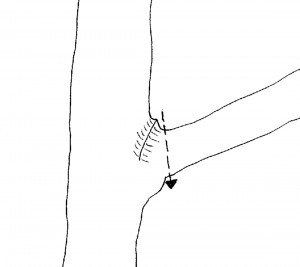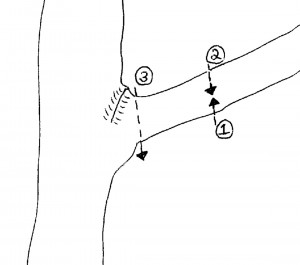


Our native trees here in the Sonoran Desert are protected species and it is usually in our best interest to maintain and care for them properly. Desert tree canopies help establish overall ecological and biological health across our delicate desert ecosystem. They provide shade and shelter for smaller plant species and our native wildlife. Without our native trees and their protective canopies, the Sonoran Desert would not be the lush, lively environment it is today.
Part of taking care of our native trees is proper pruning. Native trees in their natural form are generally just fine without pruning. In most cases, you prune a tree because you want to be able to walk around or under it, or you want the shade of a taller canopy. However, sometimes tree canopies can become unruly and overly heavy especially in multi-trunk varieties. This can cause damage to the trees, make them susceptible to breakage or splitting in our monsoon storms, or put undue stress on the plant leaving it vulnerable to disease and parasites. Likewise, poor or improper pruning can be just as harmful and put a great deal of stress on the plant.
Pruning is best done when the tree is dormant. For most native trees this is in winter. You can also prune in the fall or early spring.
You can start pruning a tree after it is three years old. There are auxins in the tips of the branches that relate directly to root growth. If you prune too many of the branch tips in the early years of the tree’s life, important root establishment will be slowed. Quicker root establishment means the tree is less prone to blowing over in winds and can get by with less water sooner.
Start from the bottom and prune up. Never top-prune a tree. Top-pruning a tree turns it into a damaged shrub.
 Start with small branches (5/8 inch or less) and use hand pruning shears. Cut as close as you can to the branch you want to keep, leaving the branch collar (a raised section of bark on the underside of the branch) intact. Cut as close as you can to the branch you want to keep, leaving the branch collar intact.
Start with small branches (5/8 inch or less) and use hand pruning shears. Cut as close as you can to the branch you want to keep, leaving the branch collar (a raised section of bark on the underside of the branch) intact. Cut as close as you can to the branch you want to keep, leaving the branch collar intact.
When you cut close to the branch you want to keep, all the energy that would have continued feeding the branch you cut off will instead go up into the branch you kept. If you cut far away from the other branch and leave a stub, you increase chances of disease, create a hazard that someone could catch an eye or an article of clothing on, and set up a bad branching effect. A branching effect is created because the energy goes into the stub but has nowhere to go. The tree then makes lots of new spindly branches – creating more pruning work. Do it right the first time! Remove whole limbs or branches and do not leave a stub.
The native trees in southern Arizona are often multi-trunk trees, and you want to maintain that natural form. Cutting off one trunk increases pruning maintenance and weakens the tree, making it more susceptible to wind damage. Multi-trunk trees provide cooling shade for a greater area on the ground than a single-trunk tree can, which reduces soil-moisture loss to evaporation. Multi-trunk trees will also hold more of the leaf drop beneath them; this free, natural mulch will help build and improve the soil.
Look for the bark ridge and branch collar
 For branches thicker than 5/8 inch, use a pruning saw and the 3-cut method. This will prevent the bark attached to the bottom of the cut branch from stripping away the bark on the remaining limb when the cut branch falls.
For branches thicker than 5/8 inch, use a pruning saw and the 3-cut method. This will prevent the bark attached to the bottom of the cut branch from stripping away the bark on the remaining limb when the cut branch falls.
Many homeowners want a super-clean, manicured look to their yard and see the seed and leaf droppings as nothing more than a mess. In reality, the best mulch for any plant is that plant’s own plant tissue. Don’t throw away your prunings and fallen seed-pods—use them as beneficial moisture-conserving and soil-building mulch! First, make a pile of any small prunings, and use your hand pruners to cut them up into 4-inch pieces so they lie directly on the soil’s surface and don’t act as the tripping hazard, pack-rat nest, or the fire fuel that piles of larger prunings can create (the seed-pods are already the perfect size). Put these fine prunings and fallen seed-pods over the soil, under the canopy of the tree’s branches, leaving clear a 3- to 6-inch ring around the trunk of the tree. That way if the mulch gets really wet after a lot of rain, and stays wet, there won’t be any rot- or fungus-producing moisture against the base of the tree trunk. The pruned branches that are too thick to be cut into smaller pieces with pruning shears can be used for crafts, fences, building, or as kindling in your fireplace. If you don’t want seed pods on your patio or walkways, simply sweep them off these surfaces and onto the unpaved soil where they can beneficially protect and feed the soil.
The tool of choice is primarily the hand pruning shears. Use the ones with scissor action rather than ones that have a flat face the blade presses down on, as this latter type of shears will compress the cut, damaging the edge of the remaining living branch.
For larger cuts, use a pruning saw that allows you to get a nice clean, close cut.
Avoid loppers, even though they are popular. You can’t get as close and clean of a cut as you can get with a saw. Loppers risk a bad pruning stub which can die back and create an entryway for insects and disease.
Make sure all tools are sharp!
If your tree has been neglected for a long time or has suffered damage due to structural issues, we recommend getting a trained professional to properly prune your trees. Often, trees are left alone too long or have been improperly pruned in the past and the tree really needs an experienced eye to ensure a healthy, balanced, structurally stable plant. Earth Care provides tree pruning services under the supervision of a trained, experienced, certified arborist specializing in native trees. To schedule a tree pruning, contact us today.
This post was adapted from the multi-trunk tree pruning guide found at desertharvesters.org.